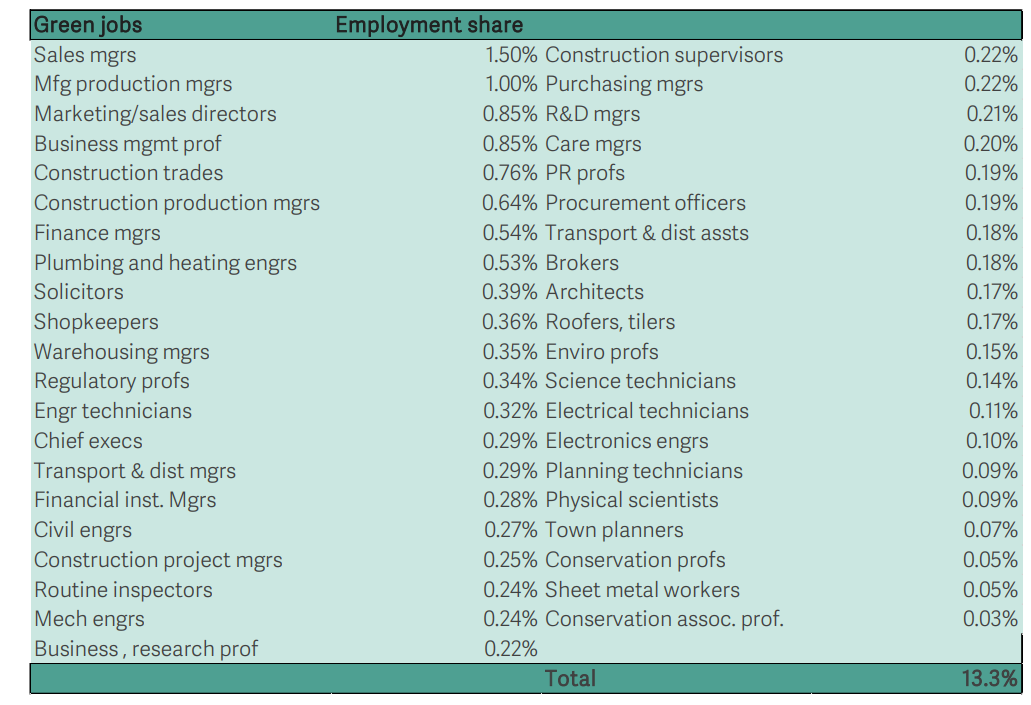The UK’s experience of structural change through deindustrialisation during the 1970s and 1980s drove up unemployment, concentrated among particular parts of the population, and left deep scars on some parts of the country. However, the net zero transition will have impact on jobs across the economy but is unlikely to follow the same path as these previous episodes of change. Molly Broome, Stefano Cellini, Kathleen Henehan, Charlie McCurdy, Capucine Riom, Anna Valero, and Guglielmo Ventura assess the likely scale – and nature – of labour market change brought on by the net zero transition over the next decade.
| #LSEUKEconomy |
|---|
The net zero transition involves the invention and diffusion of new technologies across and within sectors of the economy, with the Climate Change Committee (CCC) estimating that 84 per cent of decarbonisation to 2035 will involve new technologies or low carbon fuels, either alone or in conjunction with behaviour change (and the remainder involving behaviour change alone). Indeed, the government has stated its intention to lead the world into a new ‘Green Industrial Revolution’, by investing in clean technologies such as wind, carbon capture, hydrogen, and others. High-carbon industries, in particular, will see significant change in terms of technologies, processes and demand, with implications for those that work in them.
The net zero transition won’t repeat the job destruction of deindustrialisation
We identify sets of ‘green’ and ‘brown’ jobs that we expect to face significant change in their nature of work. Broadly, our green jobs relate to activities consistent with delivering the net zero transition: we classify a set of ‘core green task’ jobs which contain significant green-task content and can therefore be considered ‘directly’ green (based on a mapping from detailed occupational classifications carried out in the United States by O*NET). Occupations that are particularly prevalent in the most emissions-intense sectors, and therefore those that require significant change to be consistent with net zero, are classified as ‘brown changers’.
Our approach identifies 34 brown-changer occupations (which together represent 4 per cent of people employed in 2019, or 1.3 million workers) for whom these types of changes are likely to apply. Within this group, some brown occupations whose primary function directly contributes to the generation of greenhouse gas emissions are likely to experience further decline: an obvious example would be coal mining operatives, which now only accounts for 0.01 per cent of employment (or just 2,700 workers overall). This is the group of workers that tend to be discussed as being particularly at risk due to the transition, given the previous negative experience of UK regions diversifying out of high carbon activities. Workers in other brown jobs, like large goods vehicle drivers, will still be required in a net zero world, but will need to adapt to new, lower-emissions technologies and new ways of working. Others still will require significant change in both the technologies they use and the skills they deploy; for example, ship builders will need to learn to build lower emissions vessels. Indeed, some of the brown jobs we identify already involve new green tasks and skill – such as energy plant operatives or production managers in mining and energy – but it is likely that more change will be required, given the urgent need to further decarbonise this decade.
Change will be felt for people already in green occupations, too. ‘New’ occupations, like wind turbine engineers, already involve green tasks, and will likely see further technological advances and changes in skill or task requirements over time (while also seeing increases in demand). In other relatively widescale and pre-existing occupations, tasks and associated skills are likely to change somewhat; for example, operations managers will need to take on the environmental sustainability of their business’s operations.
Our approach identifies 41 occupations (representing 13 per cent of employment, or 4.3 million workers) in what we label ‘core green task’ occupations (we define these as the occupations that are the most likely to involve new green tasks and skills). Other ‘indirectly green’ jobs (such as chemists or materials scientists), that may see increased demand due to the net zero transition, but no change in tasks or skills, are not included as green jobs for the purposes of this change-focused analysis. As a shorthand, we refer to ‘core green task’ and ‘brown changer’ jobs as ‘green’ and ‘brown’ jobs, respectively.
Table 1. Core green jobs account for approximately 13 per cent of employment

SOURCE: Analysis of ONS, Labour Force Survey, classifying ‘core green task’ jobs as set out in Box 1 of the report.
The geography of green and brown jobs
Using our definitions, 40 per cent of workers in both green and brown jobs work in either construction, manufacturing, agriculture, or energy sectors, compared to 20 per cent of workers overall. In addition, green jobs (but not brown) are also overrepresented in the professional, scientific, and technical sector: 14 per cent of employment in this sector is classed as green, compared to 8 per cent nationally. When it comes to how green and brown jobs are distributed across the UK, specifically looking at Travel to Work Areas (TTWAs), we find green jobs to be particularly concentrated in parts of the south-east (for example, 17 per cent of employment in the High Wycombe and Aylesbury Travel to Work Area), London (16 per cent) and also in Malton, a market town in Yorkshire (20 per cent). By contrast, areas in Wales, Scotland and Northern England see a greater concentration of brown jobs: for example, 16 per cent of employment in Barrow-in-Furness is in a brown job, as is 11 per cent of employment in Newport and 9 per cent in Aberdeen.
The characteristics of green vs brown jobs
To understand what the net zero transition will mean for workers, we need to understand central differences between the sets of green and brown occupations we have defined. In terms of occupational characteristics, green jobs tend to be concentrated in higher paid occupational groups, with green jobs comprising 40 per cent of employment in managerial occupations, 14 per cent in professional occupations and 21 per cent in associated professional occupations (compared with 13 per cent of employment overall). Brown jobs are all but absent in these occupational groupings (comprising just 1 per cent of employment in associate professional occupations, compared with 4 per cent of total employment) but are instead highly concentrated in process and plant operative occupations, where more than one-in-four (27 per cent) of workers are in a brown job. Men are more likely than women to work in both green (18 versus 8 per cent) and brown jobs (8 versus 2 per cent).
There are differences across ethnic groups too, with white workers being the most likely to be found in green jobs (14 per cent), and significantly more likely than black workers (8 per cent). When it comes to factors like pay and qualifications, more significant differences between green and brown jobs emerge, with graduates being much more likely to work in a green job than someone with a GCSE-equivalent qualification (16 per cent of graduates are in a green job, compared to 11 per cent of those qualified to at most GCSE-level) and the reverse being true for brown jobs (3 per cent of graduates work in a brown job, compared with 6 per cent qualified to GCSE-level). Moreover, core green task jobs appear to command a wage premium of around 8 per cent on average, even after controlling for worker education and experience. Examining the nature of these groups of green and brown jobs in terms of task content we find that, on average, they tend to require very different sets of skills and tasks from one another: core green task occupations are more likely than others to require nonroutine analytical and personal tasks (which tend to be more prevalent in higher skilled occupations), and our set of brown jobs are much more likely to require routine manual and especially non-routine physical tasks.
Meeting emissions targets will require significant green jobs growth in the next decade
To help us think about whether the scale of change coming is likely to be manageable, it is helpful to consider the experience of change over the last decade. On aggregate, there’s been little change in the relative size of green and brown occupations over the past decade; the share of employment in green jobs grew by just 1.3 percentage point and the share in brown jobs hasn’t changed (remaining at 4 per cent of employment). The small net growth in green jobs has been largely driven by higher-paid roles, like marketing and sales directors, and business management professionals. Occupations that we classify as brown have – on average – tended to remain much more static as a share of employment.
However, significant change will be required over the next decade if the UK is to meet its emissions targets. Several studies have set out what this means in terms of demand for jobs and skills. For example, the Offshore Wind Industry Council estimates that the UK could employ around 70,000 in offshore wind (direct and in supply chains) by 2026 (compared to around 26,000 in 2021), the National Grid estimates there will be an additional 260,000 energy workers needed by 2050 to get to net zero, and research from the Construction Industry Training Board estimates that the UK will need 60,000 workers for heat pump installation in domestic and non-domestic buildings over the next seven years (compared to 900 installers in 2019). To understand how the UK labour market will be able to meet this future demand, we look at the very recent past in order to understand where workers in green jobs tend to come from, whether workers in brown jobs are likely to transition into green jobs, and whether workers in brown jobs that are at risk are any more likely than average to move into unemployment over the longer term.
Only a small – but growing – number of people have moved from brown to green jobs
The limited growth in green jobs over the past decade has been driven more by workers moving from non-green jobs into green jobs, rather than by young workers who recently left education or workers who were previously out of employment. A wide range of green jobs have been filled by previously non-green workers, but workers moving into green jobs tend to be highly educated and tend to move from jobs that are more similar to green occupations, for example requiring a significant number of analytical tasks. They also come from jobs with relatively high hourly pay, but they still obtain a significant pay increase of around 10 per cent after moving into a green job (there is an even larger proportional rise for those leaving brown jobs and joining green ones).
The share of brown job workers moving to green jobs has been low, although it has increased over the period considered (from only 0.3 per cent of brown workers in 2013 to 2.8 per cent in 2019). The rarity of these moves is unsurprising given that the occupational content of and the skills required in an average green occupation are different from those in an average brown job, and this makes it hard to make a direct transition. Indeed, only 1 in 7 occupational moves cover the average distance in task content that would be needed to make the switch from the average brown job to the average green job. Workers who actually performed these hard-to-make transitions from brown to green tend to be much more educated than average, and to come from brown jobs with a high content of analytical tasks (and hence more similar to green occupations to start with). The experience to date, and broader lessons from transitions in the past, can help inform larger-scale change that is coming this decade
Although some brown jobs will change as existing workers build new green skills and take on green tasks, we certainly can’t rely on it happening naturally in the future: those people who have moved over the past decade have been highly educated and have moved into fairly similar jobs (when assessed with the sort of tasks they perform). This is worrying, given both the need to see an increase in green jobs over the next decade and the need to manage transitions for those displaced from brown jobs, or finding it hard to adjust. Transitions out of, and reskilling of brown jobs – together with ensuring that the skill needs of green jobs are met – will likely require extra effort from firms, the government, and workers themselves, and such efforts are likely to vary across places, sectors, and demographic groups.
Explore our dedicated hub showcasing LSE research and commentary on the state of the UK economy and its future.
♣♣♣
Notes:
- This blog post summarises Net Zero Jobs, a report of The Economy 2030 Inquiry. The Economy 2030 Inquiry is a collaboration between the Resolution Foundation and the Centre for Economic Performance at LSE. It is funded by the Nuffield Foundation.
- The post represents the views of its author(s), not the position of LSE Business Review or the London School of Economics.
- Featured image by Nate Johnston on Unsplash
- When you leave a comment, you’re agreeing to our Comment Policy.





